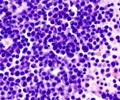Specific genes, dubbed as partner genes, which fuse with another gene to drive an often-fatal form of leukemia in infants have been identified by researchers
Specific genes, dubbed as partner genes, which fuse with another gene to drive an often-fatal form of leukemia in infants have been identified by researchers from the Children's Hospital of Philadelphia, in collaboration with the Children's Oncology Group.
By more accurately defining specific partner genes, Blaine W. Robinson, a research scientist at The Children's Hospital of Philadelphia, and his colleagues expect to better predict which infants may benefit from particular treatments.The researchers also aim to use this latest knowledge to develop new and more effective therapies for this difficult-to-treat type of blood cancer, called acute lymphoblastic leukemia (ALL).
Their goal is to target treatments to specific genes and other associated factors that become abnormal because of the gene fusions.
For the majority of infants with ALL, the problem is within the structure of a specific chromosome. In an abnormality called the MLL translocation, the MLL gene on chromosome 11 breaks and joins with any one of many different "partner" genes from other chromosomes.
The rearranged genetic region, called a translocation, leads to the production of a fusion gene and an abnormal protein and, ultimately, to leukemia.
The current study covered 221 infants with ALL in a COG clinical trial. Researchers detected MLL translocations in the ALL cells of 74 percent of the patients. The two most common partner genes that fused with the MLL gene were AF4 on chromosome 4 and ENL on chromosome 19.
Advertisement
The EFS rates with these two partner genes were even lower when the infants were less than 90 days old at diagnosis. Conversely, the survival rates were better when these partner genes fused to MLL in the leukemia cells of older infants.
Advertisement
On the other hand, outcomes were better for infants with ALL when the third most common partner gene, AF9, fused to MLL, or when the MLL gene was unaffected. In these patients, the respective EFS rates were 68 and 66 percent.
The researchers also analysed white blood cell counts (WBC)-another classic prognostic factor in leukemia. They found that when MLL was fused to AF4, the infants were far more likely to have higher WBC, while the WBC was lower when MLL fused to AF9.
More refined knowledge of how the different partner genes of MLL in infant ALL are connected to the underlying molecular biology of the disease may guide the researchers to more appropriate treatment decisions.
The findings will be presented at the annual meeting of the American Society of Hematology on Dec. 8.
Source-ANI
RAS













